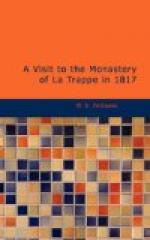In descending the steep and intricate path the traveller frequently loses sight of the abbey, until he has actually reached the bottom; then emerging from the wood, the following inscription is seen carved on a wooden cross:
C’est ici que la mort et que la
verite
Elevent leurs flambeaux terribles;
C’est de cette demeure, au monde
inaccessible,
Que l’on passe a l’eternite.
A venerable grove of oak trees, which formerly surrounded the monastery, was cut down in the revolution. In the gateway of the outer court is a statue of Saint Bernard, which has been mutilated by the republicans: he is holding in one hand a church, and in the other a spade—the emblems of devotion and labour. This gateway leads into a court, which opens into a second enclosure, and around that are the granaries, stables, bakehouse, and other offices necessary to the abbey, which have all been happily preserved.
Owing to the fatigue of the journey, the heat of the weather, and having frequently been obliged to retrace our steps, from losing our way in the woods, it was late before we arrived at the abbey. To the west, under the glow of the setting sun, the forests were still tinged with the warmest yet softest colours that faded fast away; and as we descended towards the Convent, quickening our pace to reach it before the last gleams of evening departed, there was a silence around us, which at such a moment, and in such a spot, sunk sorrowfully upon the heart! Just as I reached the gate the bell tolled in so solemn and melancholy a tone that it vibrated through my whole frame, and called strongly to mind the beautiful lines in “Parisina”:
The Convent bells are ringing,
But mournfully and slow;
In the gray square turret swinging,
With a deep sound, to and fro,
Heavily to the heart they go!
On entering the gate, a lay-brother received me on his knees; and in a low and whispering voice informed me they were at vespers. The stillness and gloom of the building—the last rays of the sun scarcely penetrating through its windows—the deep tones of the monks chanting the responses, which occasionally broke the silence, filled me with reverential emotions which I felt unwilling to disturb: it was necessary however to present my letter of introduction, and Frere Charle, the secretaire, soon after came




